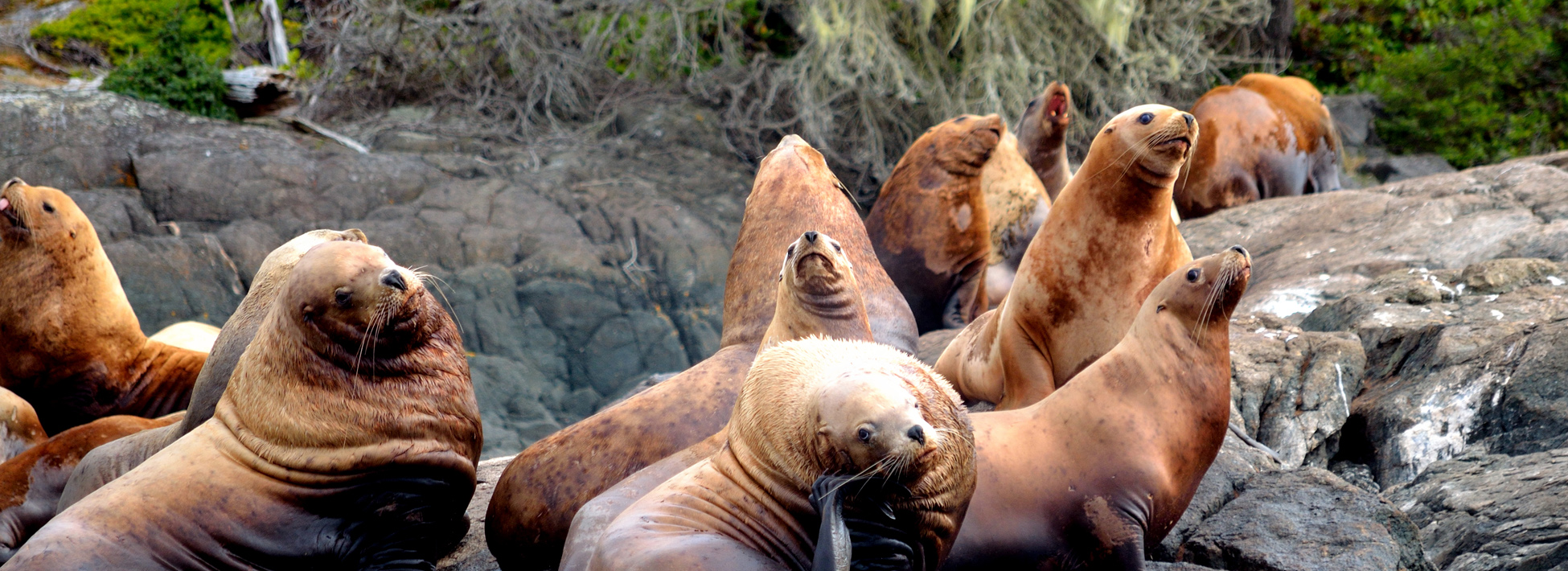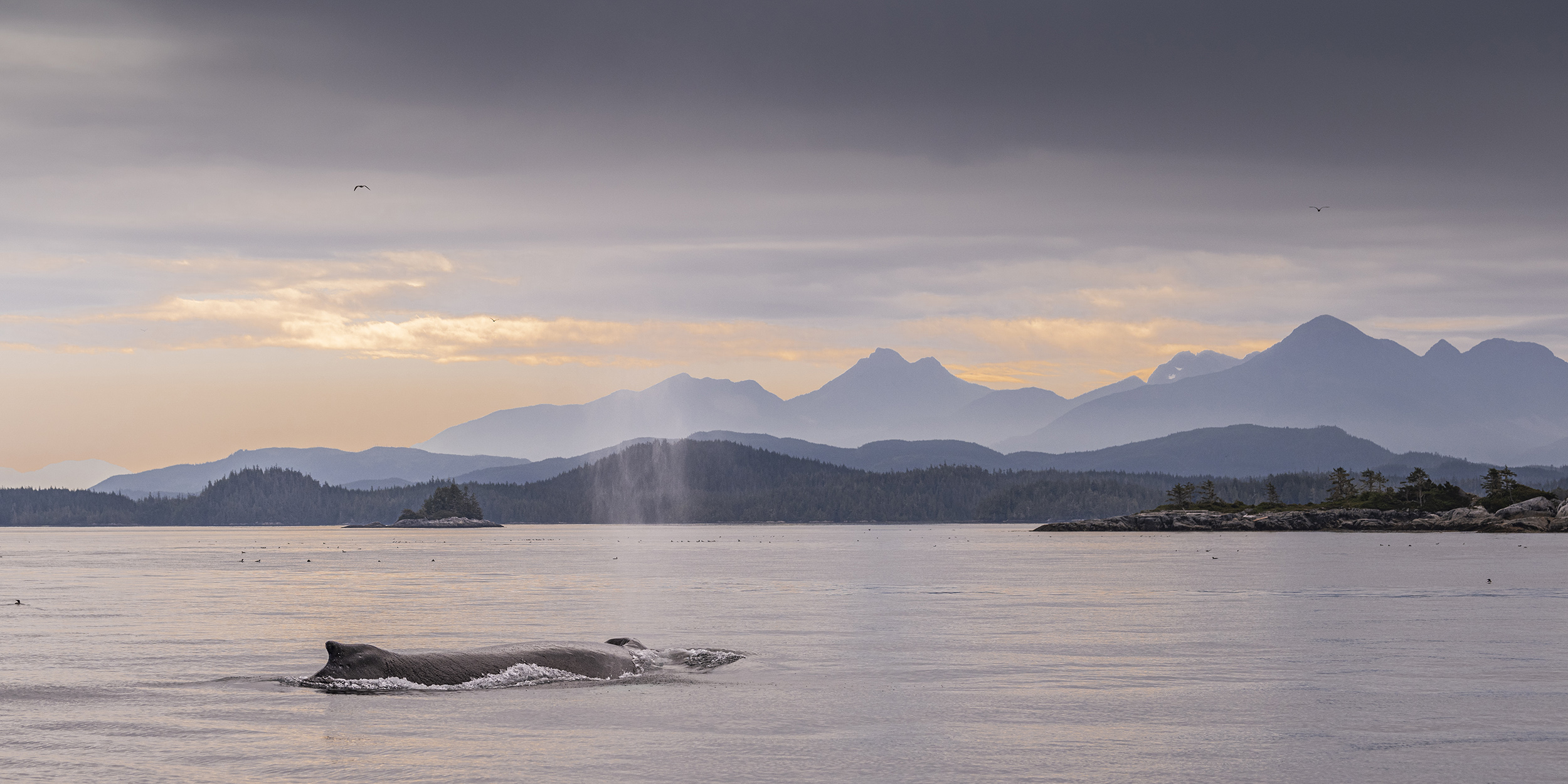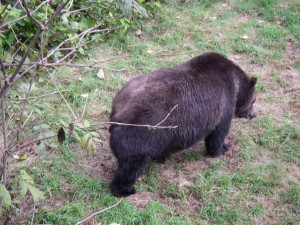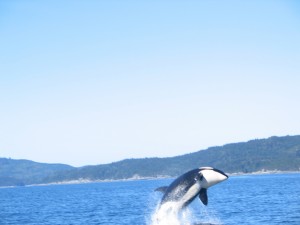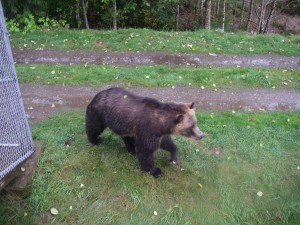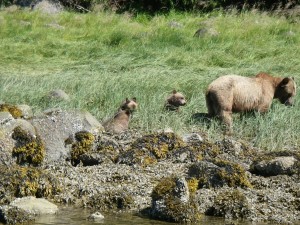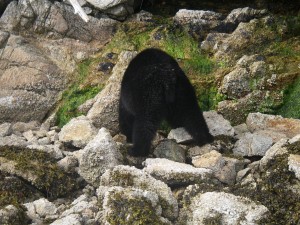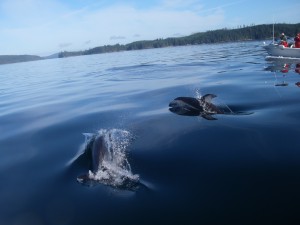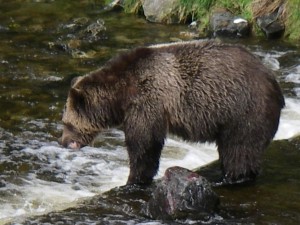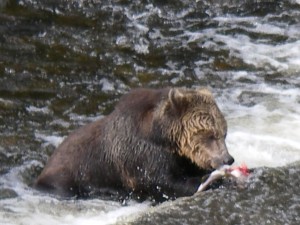 A day trip from the lodge means we travel up Knight Inlet to the Glendale River. In the fall the viewing time in the stands for Grizzly Bear Lodge is from 10:00 am to 12:00 am. The stands being a 20-minute van ride up a logging road, which parallels the river. The grizzly bears have accepted our presence and tend to ignore the stands and will pass close and even under the stands. The key is no flashes on cameras, no perfumes or other scents on the watchers, definitely no food, talking in quite voices and no sudden moves. Although the bears ignore if we overstep the guidelines they will turn in our direction and stare to let us know “they know”.
A day trip from the lodge means we travel up Knight Inlet to the Glendale River. In the fall the viewing time in the stands for Grizzly Bear Lodge is from 10:00 am to 12:00 am. The stands being a 20-minute van ride up a logging road, which parallels the river. The grizzly bears have accepted our presence and tend to ignore the stands and will pass close and even under the stands. The key is no flashes on cameras, no perfumes or other scents on the watchers, definitely no food, talking in quite voices and no sudden moves. Although the bears ignore if we overstep the guidelines they will turn in our direction and stare to let us know “they know”.
Grizzly Bear and Wildlife Viewing Blog: Monthly Archives: March 2013
Whale Watching day with orca breaching
These photos are not as good as my guests as I was using a small Pentax Opti 6.0 megapixels and running the boat – that is my excuse. But I remember the day in Johnstone Strait off the shore of Vancouver Island we came upon an adult orca that seemed to be teaching a younger orca about breaching. The adult would breach and in less than a minute the younger would do the same. As you can see there were no other boats in the area and this behaviour continued for fifteen or twenty minutes must have been more than a dozen sets of breaching. As a guide we experience many interesting every summer but this ranks in the top ten for me.
Grizzly Bear close to viewing stands
The metal cage on the right side of the photo is the entrance to one of the viewing stands located on Knight Inlet’s Glendale River. We are in the stands from August 25 to mid-October and that is a “safe” place to be when the grizzly bears are coming that close. The bears have adjusted to our presence and will pass close to and underneath the stands. The river, which contains the salmon the bears are catching, is down the height of the viewing stands (3 meters or 9 feet) and out another ten to fifteen meters. A good telephoto lens is nice but not a necessity.
A Whale Watching Safari Bonus
Breaching humpback whales may occur two or three times a week but pictures are much rarer maybe once or twice a summer. In the area of Bold Head in Blackfish Sound near Telegraph Cove on Vancouver Island there are quite a few humpback whales. It is common to see six to ten whales each safari as the area has an abundance of herring, which is one of the whale’s main foods. The humpback whales arrive in late May to early June and remain in the area through October.
Knight Inlet and Spring Grizzly Bears
Knight Inlet’s Glendale River estuary is our normal viewing area for grizzly bears in the spring. The salmon have not arrived so one of the main source of food in the protein rich sedge grass which grows at the river mouth. Mother grizzly bears and cubs, in this case by their size they are last years cubs, come to the area for the sedge grass. At lower tides when the beach is exposed they turn over rocks for the high protein food of crabs, clams, barnacles, amphipods and other tiny invertebrates. These grizzlies remain in the area until the salmon arrive in August and then move up the river and we follow them to the viewing stands on the river.
Knight Inlet Black Bear Watching
This is not an uncommon pose to a black bear or even for a grizzly bear. Bears are on the beach in the spring because plant food is relatively scarce during spring and bears will continue to loose weight until well into June. Plant foods make up the majority of a bear’s diet (sometimes, as much as 90%). The black bears are kept from the salmon rivers by the grizzly bears so the beaches remain one of their main sources of protein all year. I believe
this “back to us pose” is because the beach slopes down to the water line and it is easier to roll rocks downhill.
Pacific white-sided dolphins – Whale Watching
Pacific white-sided dolphins are only one of the many mammals often viewed on the whale watching day. Dolphins tend to travel in pods of several hundred the largest pod I have come across was between fifteen hundred and two thousand. This was in the late fall and they appeared to be heading out of the area. The pods we encounter in the summer are playful and come to our boats out of curiosity. In this case we were stationary as the dolphins were following another of our boats. At other times they will pass beneath our bow while we move along side a large pod.
Signs of Grizzly Bear success
This grizzly bear is guarding a good fishing location. Look close at the large rock and notice the salmon blood. It is always nice to have a table close when you are catching food and need to eat it on site. Being able to place the salmon on the rock and eat the best parts always speed up the process and then back to fishing. The best parts depend on the individual grizzly bear and time in the fishing season. The best could be the head for mineral content, eggs and belly high in protein, or the skin with it’s layer of fat. Many bears devour the whole salmon early in the fishing season and then become more selective once they have reached a certain size, which means a successful hibernation.
Guest Comments about trip to lodge

“Our holiday was in Mid September. We have shared stories of our stay ever since and will continue to do so, as our host John Reid with his wife & team gave us the benefit of truly unforgettable experiences. From the greeting off the seaplane with the three other couples on our flight, a massive bowl of sea food with all guests, a short walking tour to a nearby building (to listen to its history), a glorious meal, comfortable & relaxing accommodation, motorboat trip to find ourselves right where the killerwhales passed by (playing around our boat…Glenn was a gem as his love of the marine life was evident), beautiful lunch, another superb meal and on the third day a motorboat / minibus trip to our best ever wildlife experience….grizzlies and cubs feeding on wild salmon…our photos need no commentary, to a leisurely afternoon where I won a tee shirt (golf shot from front lawn to nearest a selected object) and John saw as off back on the seaplane.”
Grizzly Eating Salmon – Knight Inlet
The reason Grizzly Bear Lodge is successful viewing bears on Knight Inlet’s Glendale River is the presence of salmon in the man-made spawning channel. The salmon arrive in the area mid-August and we are permitted to travel to the viewing stands from August 25 to mid-October. Most salmon caught by the grizzly bears are eaten on site moving off the river to eat would mean loss of a prime fishing position. There is a change in the bears as we watch from the viewing stands as it is possible to eat only so many salmon at one time and we are in the stands for two hours. The time limit is determined by government regulations.
